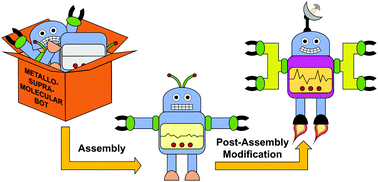当前位置:
X-MOL 学术
›
Chem. Soc. Rev.
›
论文详情
Our official English website, www.x-mol.net, welcomes your
feedback! (Note: you will need to create a separate account there.)
Covalent post-assembly modification in metallosupramolecular chemistry
Chemical Society Reviews ( IF 40.4 ) Pub Date : 2017-11-16 00:00:00 , DOI: 10.1039/c6cs00907g Derrick A. Roberts 1, 2, 3 , Ben S. Pilgrim 1, 2, 3 , Jonathan R. Nitschke 1, 2, 3
Chemical Society Reviews ( IF 40.4 ) Pub Date : 2017-11-16 00:00:00 , DOI: 10.1039/c6cs00907g Derrick A. Roberts 1, 2, 3 , Ben S. Pilgrim 1, 2, 3 , Jonathan R. Nitschke 1, 2, 3
Affiliation

|
A growing variety of covalent reactions have been employed to achieve the post-assembly modification (PAM) of self-assembled metallosupramolecular complexes. Covalent PAM enables the late-stage derivatisation of pre-assembled parent complexes in a modular fashion, thus expanding the chemical space available for supramolecular synthesis. The oldest and most widespread implementation of covalent PAM is in metal-preorganised covalent synthesis. Recent work, however, has broadened the scope of covalent PAM to include: protocols for efficiently grafting new functionalities onto supramolecular architectures, reactions that permanently ‘lock-down’ metastable complexes, and covalent bond-forming stimuli that trigger controlled structural transformations between distinct supramolecular species. This review highlights key examples of each of these distinct kinds of covalent PAM in metallosupramolecular chemistry, before providing a perspective upon future challenges and opportunities.
中文翻译:

金属超分子化学中的共价组装后修饰
越来越多的共价反应已用于实现自组装金属超分子复合物的组装后修饰(PAM)。共价PAM能够以模块化的方式对预组装的母体复合物进行后期衍生化,从而扩大了超分子合成可用的化学空间。共价PAM的最古老和最广泛的实现是在金属预组织的共价合成中。但是,最近的工作将共价PAM的范围扩大到包括:有效将新功能嫁接到超分子体系结构上的协议,永久性“锁定”亚稳复合物的反应以及触发不同超分子之间受控结构转变的共价键形成刺激。物种。
更新日期:2017-11-16
中文翻译:

金属超分子化学中的共价组装后修饰
越来越多的共价反应已用于实现自组装金属超分子复合物的组装后修饰(PAM)。共价PAM能够以模块化的方式对预组装的母体复合物进行后期衍生化,从而扩大了超分子合成可用的化学空间。共价PAM的最古老和最广泛的实现是在金属预组织的共价合成中。但是,最近的工作将共价PAM的范围扩大到包括:有效将新功能嫁接到超分子体系结构上的协议,永久性“锁定”亚稳复合物的反应以及触发不同超分子之间受控结构转变的共价键形成刺激。物种。











































 京公网安备 11010802027423号
京公网安备 11010802027423号